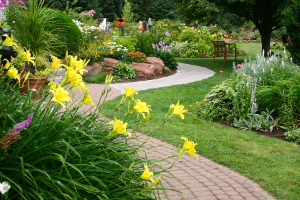An outdoor shower can be more than just a place to rinse off, it can be a garden design element
Story: Rachel Belshaw
The outdoor shower is showing increasing popularity and becoming a sought-after item in the modern backyard. It can be as elaborate or as modest as you like; some are simple shower-only areas, reminiscent of the beach-style versions you often see surfers rinsing under, while others like to indulge in a bath on its own designated deck area. Whatever your fancy, an outdoor bathing area will prove a handy addition to your backyard.
Ethan Fierro, author of The Outdoor Shower, is a designer and builder based in Maui, Hawaii. He has also noticed the increase in the outdoor bathing area, even overseas. “I find there’s a growing number of enthusiasts regarding the shower and bathing in the out-of-doors, especially in our ‘cyber’ age that has people locked up in climate-controlled environments for work, play and at home. People are realising that the simple (and necessary) act of daily ablutions performed in an outdoor shower can reconnect them with a sense of peace, quietude, contemplative appreciation of nature and a simple means of attaining serenity. Many home owners who spend time nurturing their yards, gardens and exterior surroundings are able to relax and digest their hard labours while showering outside in that very place,” he says.
There are a few common reasons people seek out an outdoor shower in Australia, according to Rainware Outdoor Showers’ manager Stephen Gowlett. “The obvious reason is after a pool or beach swim and to wash off sweat and dirt before jumping in to save the pool chemicals. Other reasons include rinsing off after gardening and mowing without going inside, and to minimise the water trail from the pool to the indoor bathroom,” he explains.
Ethan says the outdoor bathroom can also do wonders for the user’s wellbeing while maintaining sustainability. “The user can appreciate their natural surroundings, while enjoying the feeling of bathing in open air — there’s no claustrophobic indoor bathroom feeling and they can use the grey water to irrigate plantings around the property while having a low impact on the environment,” he says.
The construction of an outdoor bathing area can be as detailed or as simple as you like. In his experience, Ethan has used many materials when designing and building outdoor showers. Wood, stone, brick, found objects, glass, bamboo, tile, tree trunks and branches, shingles, ornamental grasses and other plantings — your imagination can run wild when you think about all the possibilities. Start with a budget, then take into consideration the current or future theme of your backyard and be sure to integrate the outdoor bathroom with these elements.
Outdoor showers can be freestanding or wall-mounted, depending on the space allocated and, says Stephen, there is no limit on the amount of space required but as a guide, one-metre-square is comfortable. Showers can be sloped, curved or straight to suit most tastes and many outdoor showers are made from marine-grade stainless steel as well as powdercoated aluminium, both of which suit most contemporary outdoor settings.
You can also get freestanding timber showers, available from retailers such as Freedom Furniture or specialist outfits like The Art of Nature. The latter makes handcrafted plantation-grown teak showers equipped with stainless-steel and chrome fittings. They look great and have the advantage of being portable but require more maintenance.
If you’re concerned about privacy when deciding where to place and how to set up your outdoor bathroom, there are a few things to consider. “Ensure sightlines from surrounding buildings are taken into account when locating the shower or bath’s position,” says Ethan. “Build the shower with the most shy of potential bathers in mind. Make sure there is enough privacy screen around the shower, but include window openings for the bather to look out at the surroundings where desired.”
Remember, your local hardware or garden store may have supplies such as panels, reed and fences that could act as privacy screens. When accented, these can complement the theme of your yard while being an economic solution.
A stand of fast growing bamboo can also make for a great privacy screen while adding to the resort ambience of your outdoor shower area.
In these water-savvy times, it’s important to take into consideration how much water you can save and reuse. Find yourself a government-approved shower with the highest possible rating (three stars), such as those from Rainware Outdoor Showers.
“Also consider whether the water will be supplied from the mains or a rainwater tank and whether you will be using hot water from your hot water tank and, of course, where the water run-off is going to go — the stormwater drain, garden or sewage system?” suggests Stephen.
Most domestic showers use as little as nine litres of water per minute, but it is possible to find one that uses less. “Use as little water as possible so the run-off can go directly into the garden or lawn or, if no soap is used, back into the pool,” continues Stephen. “Also, buy a product that will last outdoors and seek out a company that gives a decent warranty.”



